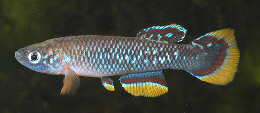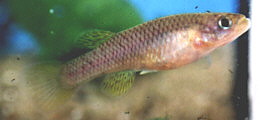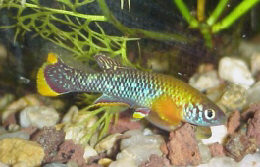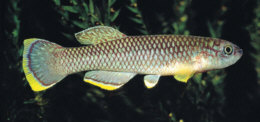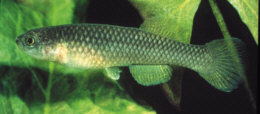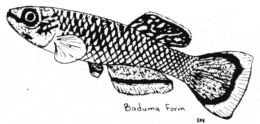Fundulopanchax cinnamomeus (Clausen 1963)
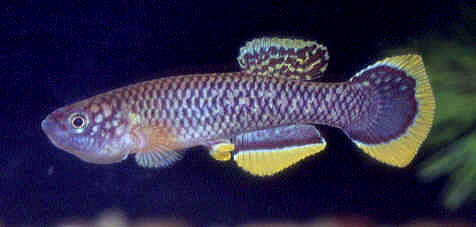
Fp.cinnamomeus Kumba. Photo courtesy of Ed Pürzl.
| Meaning of Name |
Cinnamon colouration of the body. | |||||||||
| First Description |
Clausen H.S. 1963. (Aphyosemion cinnamomeum). Description of three new species of Aphyosemion Myers, from Nigeria & Cameroon. Videnskabelige Meddeleser fra Dansk Naturhistorisk Forening 125: p 201-203, plate 7, figures d-e. | |||||||||
| Size |
6 cm | |||||||||
| Meristics |
| |||||||||
| Karyotype |
n = 20, A = 33 (Scheel 1972) | |||||||||
| Sub-Genus |
Paraphyosemion | |||||||||
| Group |
gardneri | |||||||||
| Synonyms |
| |||||||||
| Populations
|
Baduma - Collected in 1973 in a small brook north of Baduma on the road to Mamfe. | |||||||||
| Type Locality |
44 miles north of Kumba. This biotope was a small stream in a low mountainous area. Stenholt Clausen found this sp. on an isolated plateau 10 miles wide with deep gorges falling away on each side. | |||||||||
| Distribution |
Restricted to a narrow plateau between mount Rumpi &
the Cameroon mountain chain, inhabiting waters drained by the Mungo River system.They
have been collected between 9 & 54·7 kms south of Manyemen towards
Mambanda (Kumba). | |||||||||
| Habitat |
Brooks & streams in rain forest areas with high rainfall (50" per year). Biotopes sit over volcanic rock. Scheel in ROTOW 1 records water of 1.5 GH & pH 6.8. Reportedly caught with Procatopus similis. | |||||||||
| Distinguishing Characteristics |
This sp. is one of the only members in the genus to be completely devoid of red pigment. The nearest sp. showing any degree of similarity is A.celiae. These can be easily seperated as A.celiae has red spots on the body (generally). The caudal fin of Baduma has a squarer pattern than the population from Kumba. See Killi-News 117. Not really possible to confuse this sp. with other sp. | |||||||||
| Colour/Pattern Variability | Fairly low but males do show a variance in the shape & size of the black crescent marking in the caudal fin between populations. | |||||||||
| History |
First discovered by Stenholt Clausen on an isolated plateau 10 miles wide with deep gorges falling away each side. He collected 6 males & 2 females. The biotope was a brook 44 miles north of Kumba. See Killi-News 29. Scheel received specimens from Clausen in 1960
which were bred (?) & distributed over various countries. Their
is a 4 year gap here, but eggs were distributed in this period. Scheel
considered this sp. fairly easy to breed but biased towards males in
how young sexed out. In March 1963 Stenholt Clausen described them as Aphyosemion cinnamomeum within the then subgenus Fundulopanchax. Scheel visited the site in 1966 & remarked in ROTOW 1 that the area was on 'top of a low range of mountains between the main block of the Cameroon Mountains and Mount Roumpi, west of the chain'. Scheel regards this sp. as not a good swimmer regarding distribution. Below the southern slope of the plateau he discovered Aphyosemion celiae & described them in 1971. On January 17th 1966 a visiting German aquarist (unnamed) gave the BKA a few sp. including the then A.cinnamomeum. These were put into the new species committee of the day for breeding & distribution. It was reported at the time that they were new to the BKA. On August 8th the BKA received a wild shipment from Cameroon containing this sp. In 1972 some BKA members went to Vienna & brought back some eggs. Many of these eggs hatched out on the return journey but 6 fry survived to form a brood stock. In 1970 A.C.Radda found a population at Baduma. | |||||||||
| Breeding Notes |
Eggs are layed at all levels of the tank. Females should be rested frequently. Water stored eggs take 3-4 weeks of incubation. Dry storage can be hit & miss as eggs may take 7-14 days after wetting to hatch. Growth may be observed as rapid in the early stages. Sexual maturity takes about 2 months but full size may take 4-5 months. Reportedly does not eat young. I have spawned 2 populations - Bètook & Kombone both of which were distributed in the UK in the early '80's. These I found a little harder to breed than a typical Aphyosemion. This was undoubtedly due to the hard water used (pH 8, DH 10). Eggs were few & laid in bottom mops which were taken off & laid on wet peat for one month prior to wetting. Scheel in ROTOW
1 reports that this sp. is easy to keep in hard, alkaline water
but when kept in soft, acid water they are susceptible to disease including
Mycobacteria & velvet. Eggs are reportedly layed at the bottom of
the tank. Bob
Heap in BKA newsletter No.117, May 1975 wrote an article regarding his breeding
attempts with the Baduma population. Jaroslav Kadlec in BKA newsletter No.279, November
1988 noted the parents to be moderate feeders not eating a great deal. An unamed author in BKA Killinews No.325, October
1992 reported they prefer cooler water between 20 - 24°C with a
pH of 6·8. For conditioning it was recommended to feed Bloodworm
& mosquito larvae. | |||||||||
| Diameter of Egg | 1·5mm | |||||||||
| Remarks |
Not often seen probably due to its difficulty in breeding
& lack of colouration although the Supè population was seen in the
BKA around 1997. |


